MEMORY & SPATIAL DESIGN
BA Thesis
Theoretical Work & Graphic Design
2022
Theoretical Work & Graphic Design
2022
“Memory and Spatial Design: An Exploration of the Collective Memory of Non-Residential Architecture and Interior Design in the Former GDR”
With the end of the German Democratic Republic (GDR) more than 30 years ago, a process of determining the ‘right’ way to remember the autocratic state began that continues to this day. Heated debates have been going on ever since about what may be remembered and how it may be remembered–and they ultimately include the material legacy of the GDR.
Much of it, including architecture and interior design, fell victim to a rushed erasure of GDR heritage, a need for renewal and the devaluation of GDR design, especially in the first ten to fifteen years after reunification. Only in recent years has it been possible to take a less biased look at the value of East-German architecture.
My thesis explores how this ongoing process has influenced collective memory and how it is linked to spatial design. Further, there is also the question of the extent to which architecture and interior design and the associated collective memory find a place in discourse and the public sphere.
The work is based on an initially set theoretical framework of collective, cultural and communicative memory and its specification with regard to the built environment.
With the end of the German Democratic Republic (GDR) more than 30 years ago, a process of determining the ‘right’ way to remember the autocratic state began that continues to this day. Heated debates have been going on ever since about what may be remembered and how it may be remembered–and they ultimately include the material legacy of the GDR.
Much of it, including architecture and interior design, fell victim to a rushed erasure of GDR heritage, a need for renewal and the devaluation of GDR design, especially in the first ten to fifteen years after reunification. Only in recent years has it been possible to take a less biased look at the value of East-German architecture.
My thesis explores how this ongoing process has influenced collective memory and how it is linked to spatial design. Further, there is also the question of the extent to which architecture and interior design and the associated collective memory find a place in discourse and the public sphere.
The work is based on an initially set theoretical framework of collective, cultural and communicative memory and its specification with regard to the built environment.
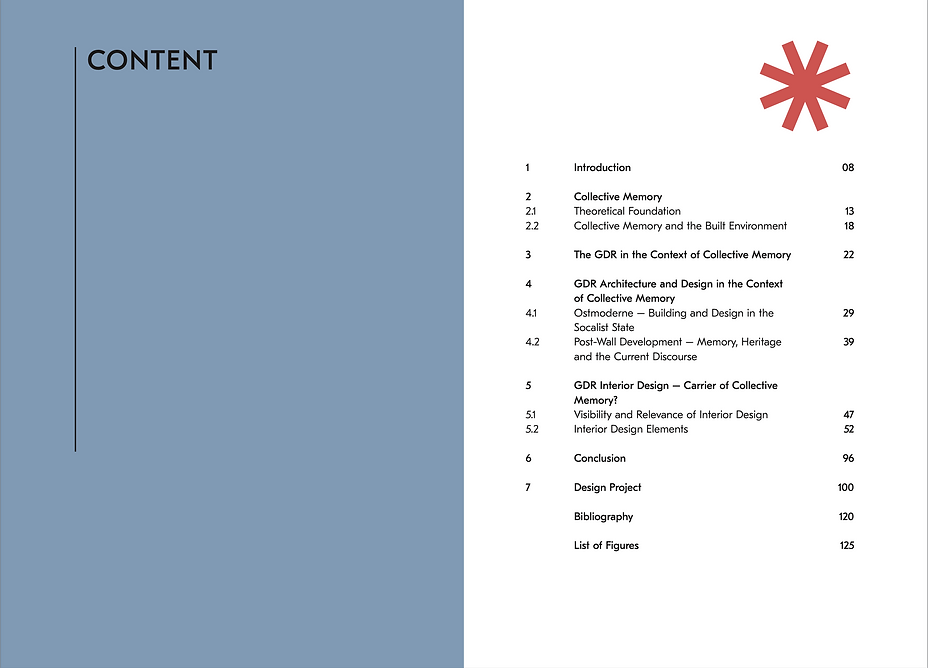
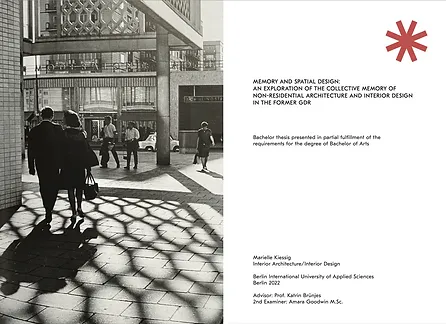
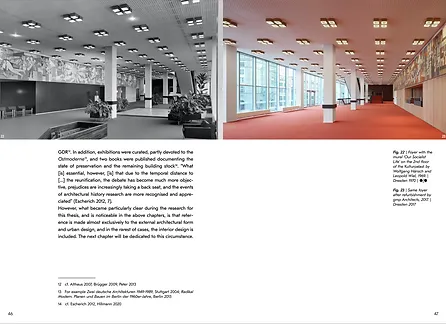
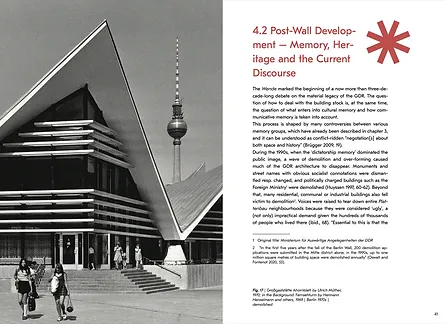
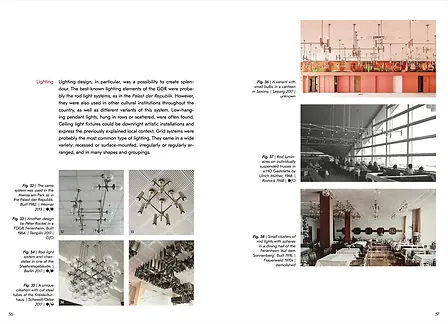

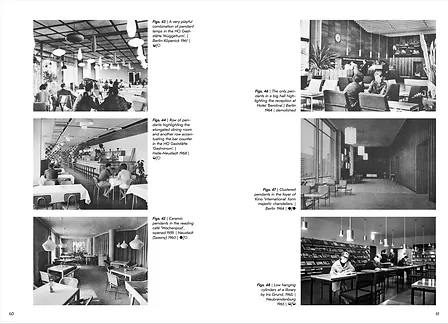
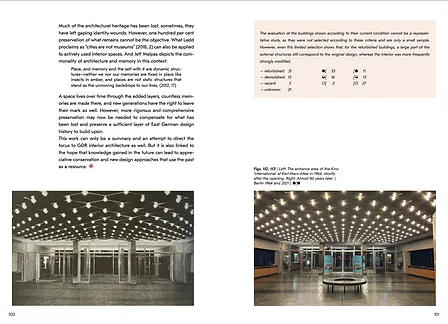
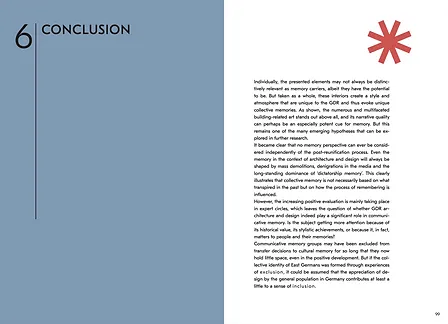
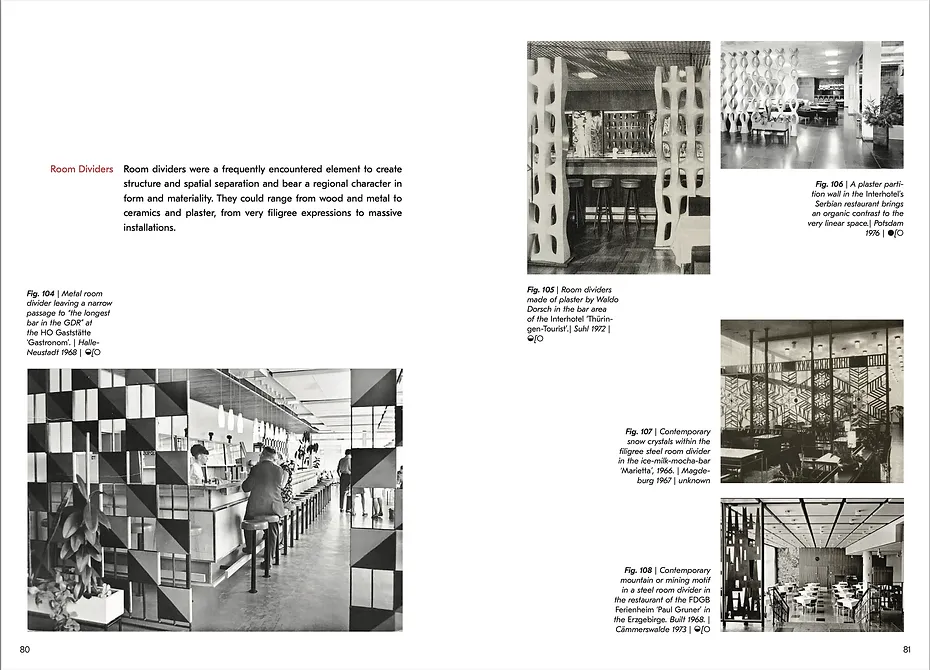
Moreover, the historical background of GDR architecture as well as the categories relevant to this work, such as 'Gesellschaftsbauten', was examined in order to then relate them to the post-reunification treatment of non-residential buildings, particularly in the context of memory, heritage protection and the development of the discourse in this regard, not least to identify research gaps that need to be filled.
It became particularly clear that there is little information about the interior architecture of the GDR, especially for non-residential buildings. The aim has been to grasp the reasons and possible consequences. Within the scope of this work, it was only possible to make a rudimentary attempt to resolve the invisibility by starting a collection of interior design elements that would reveal characteristic features of GDR design. Both historical and contemporary visual material was used.
It became evident that no memory perspective can ever be considered independently of the post-reunification process. Even the memory in the context of architecture and design will always be shaped by mass demolitions, denigrations in the media and the long-standing dominance of ‘dictatorship memory’. This clearly illustrates that collective memory is not necessarily based on what transpired in the past but on how the process of remembering is influenced.
This work could only be a summery and an attempt to direct the focus on GDR interior architecture as well. But above all, it opened many further questions and inspired future research inquiries.
I intend to continue my research in this area and will have to limit myself to one of the following possibilities/open questions:
It became particularly clear that there is little information about the interior architecture of the GDR, especially for non-residential buildings. The aim has been to grasp the reasons and possible consequences. Within the scope of this work, it was only possible to make a rudimentary attempt to resolve the invisibility by starting a collection of interior design elements that would reveal characteristic features of GDR design. Both historical and contemporary visual material was used.
It became evident that no memory perspective can ever be considered independently of the post-reunification process. Even the memory in the context of architecture and design will always be shaped by mass demolitions, denigrations in the media and the long-standing dominance of ‘dictatorship memory’. This clearly illustrates that collective memory is not necessarily based on what transpired in the past but on how the process of remembering is influenced.
This work could only be a summery and an attempt to direct the focus on GDR interior architecture as well. But above all, it opened many further questions and inspired future research inquiries.
I intend to continue my research in this area and will have to limit myself to one of the following possibilities/open questions:
- collecting and analysing the interior design of non-residential buildings, identifying design schemes
- identify the reasons for the lack of focus on interior design through qualitative studies and thereby define research gaps to be filled in future studies
- investigating the role of the interior design of 'Gesellschaftsbauten' for communicative memory through qualitative studies involving former GDR-citizens
- several possible comparative approaches: differences in memory recollections by age, gender, origin etc.
- exploring how communicative memory can be integrated into the process of heritage protection specifically for GDR architecture
If you are interested in a private copy, please contact me via email.
